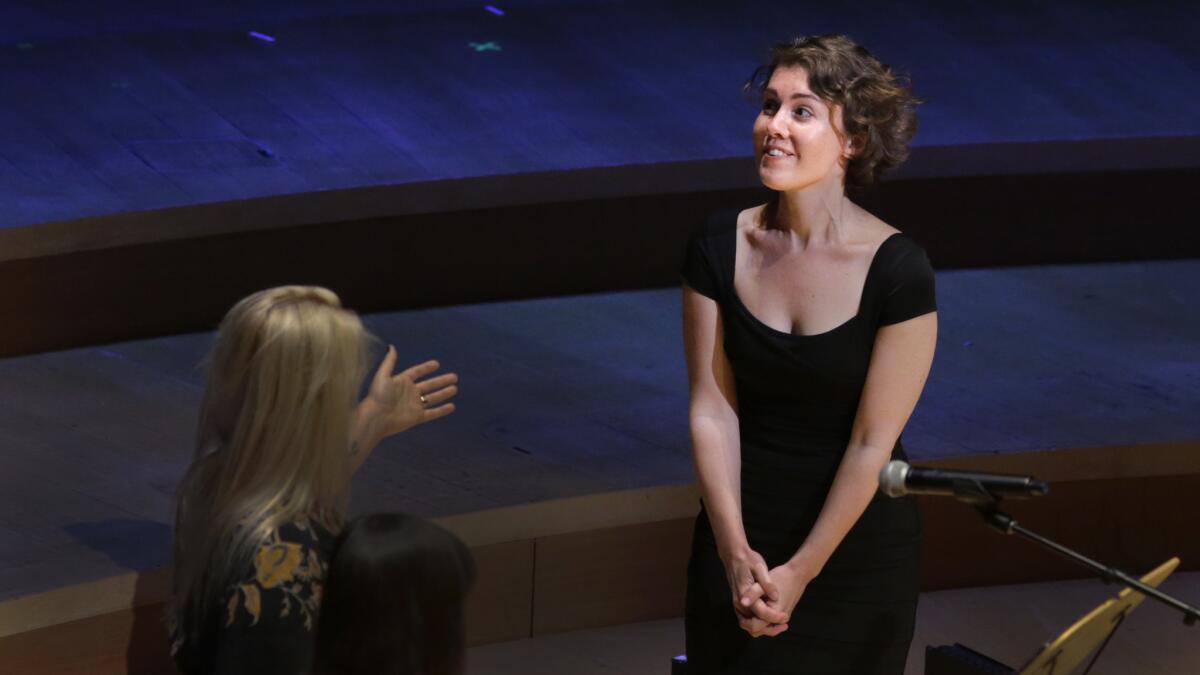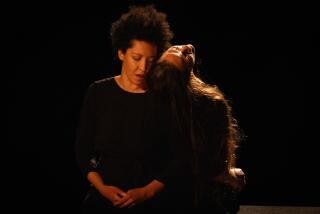‘Bombshell’ composer keys in on women’s voices
Three women get on an elevator. Their voices of dissent are about to bring down Roger Ailes, the top dog at Fox News, who has cultivated a culture of workplace sexual harassment for years.
Musically, this symbolic moment in “Bombshell” — the first and only time Gretchen Carlson (Nicole Kidman), Megyn Kelly (Charlize Theron) and Kayla Pospisil (Margot Robbie) appear onscreen together — is accompanied by three women’s voices. Pulsing with jagged “ha’s” and harmonizing in creamy chords, the voices of Caroline Shaw, Petra Haden and Susanna Hoffs fill the elevator’s potent silence.
What did Jennifer Lopez, Charlize Theron, Renée Zellweger, Awkwafina and Cynthia Erivo talk about when they got together for a conversation?
“It is literally the point at which I think the movie goes from being dominated by Roger’s power to a slightly different formulation of who’s taking control of the story,” said composer Theodore Shapiro.
Shapiro, who previously scored “Game Change” and “Trumbo” for director Jay Roach, had the idea of using female vocals early on after reading the script by Charles Randolph. He and Roach were both inspired by the modern vocal music of Haden’s solo albums and Shaw’s Pulitzer Prize-winning music for her group, Roomful of Teeth.
A personal experience brought home what women go through for ‘Bombshell’ screenwriter Charles Randolph.
Shapiro convened an improvisational session with Haden and Hoffs — co-founder of the Bangles and Roach’s wife — and had them “riff” on several musical ideas. He then cut those into the score as he composed it and at the end of the process, Shaw came in and recorded final vocals. The end result features a combination of all three singers, with Shaw most prominent.
“I have my own personal relationship and feelings about Fox News,” said Shaw. “So I was happy to be a part of anything that looks critically at that.”

Shapiro wasn’t operating merely on the metaphor of a trio of women’s voices. The articulation and style of the vocal writing speaks to the heart of the story.
“It’s about these news anchors presenting themselves to the world in a certain way, and presenting a surface to the world,” he noted. “The idea of using these kind of detached vowels felt like it tapped into that idea of self-presentation. Those syllables can sound alternately both very robotic and detached, and then also can drift into sounding emotional.”
“I use the voice in a lot of different ways in my music,” said Shaw, who had such a good time collaborating with Shapiro that they’re brainstorming more projects together. “What’s interesting about Teddy’s score is that it wasn’t about singing a song — it wasn’t using the voice as you traditionally hear it but really as a very colorful, rich instrument that can bring a certain texture to the scene, but while having that really human quality. The sound that I was always making was something that was confident but kind of mysterious. And then it becomes a little bit more brash as it goes on.”
As good a fit as the vocals were, Shapiro quickly realized he could use them only sparingly. After appearing in a brief overture (of sorts) at the top of the film, they aren’t heard again until that elevator scene.
“They were such a strong presence in the film when they appeared,” said Shapiro, “that when we first experimented with having them go throughout the score, it just felt like (a) it was too much, and (b) it sapped the power of them. So we made a conscious choice to withhold them until that pivotal scene, where the movie really takes a turn.”
The other sonic world in Shapiro’s score represents Ailes’ own self-perception, which came from conversations with Roach — “Ailes seeing himself as this very hard-nosed, practical person who saw the world as it really is,” said Shapiro. “I wanted to write music that was texturally hard: pianos playing very staccato, and strings playing these very harsh plucks, and all of it miked very close up.”
He wrote for an unconventional ensemble: a full-throated brass and percussion section but only seven string players. Much as he’d done with the singers, Shapiro brought in three musicians from the new-music ensemble yMusic — Rob Moose, Nadia Sirota and Gabriel Cabezas — for an improvisational session before the full score was recorded, and their sound informed the final draft.
Attorneys for Fox News Chairman and Chief Executive Roger Ailes are denying allegations of decades-old incidents of alleged sexual harassment that are surfacing in the aftermath of the lawsuit filed by former anchor Gretchen Carlson.
Tonally, the film walks a tightrope of meta workplace comedy, political thriller and outright, real-life horror. (The squeamish scene where Ailes, played by John Lithgow, has Kayla audition for him by hiking up her skirt plays without score.) Shapiro said Roach’s movie seemed to accept his score’s style and approach — particularly the vocal material — from the get-go.
“The sound of those vocal syllables is ‘ha,’ which has the ability to almost sound like laughter,” Shapiro said. “You know, it has a lightness to it. And, somehow, the tone that we found from the beginning of the process seemed to encompass, or it seemed to walk that line between, the drama and the lightness that is in the film.”

Vocalists Caroline Shaw, Petra Haden and Susanna Hoffs perform the “Elevator Trio” from Theodore Shapiro’s “Bombshell” score.
More to Read
Only good movies
Get the Indie Focus newsletter, Mark Olsen's weekly guide to the world of cinema.
You may occasionally receive promotional content from the Los Angeles Times.












